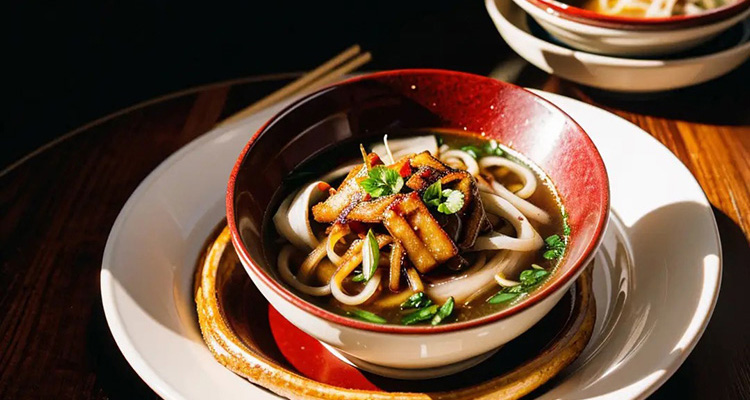Qianshan Hot Soup Rice Noodles: A Warming Jiangxi Breakfast Delight
When a steaming bowl of rice noodles is placed in front of you, the milky-white broth glistening with green scallions and thin slices of meat barely visible among the noodles — that’s Qianshan Hot Soup Rice Noodles, a comforting dish that brightens the morning! Take a sip of the broth first; its rich umami instantly awakens your taste buds. Then, pick up some noodles soaked in the soup — smooth, aromatic, and infused with the essence of Jiangxi’s Qianshan mornings.
1. Origin and History
Qianshan Hot Soup Rice Noodles originated in Qianshan County, Shangrao, Jiangxi, as a quick meal invented by boatmen along the Xinjiang River. During the Ming and Qing dynasties, Qianshan was an important Jiangnan port, and boatmen would quickly cook locally made rice noodles in boiling broth, creating this convenient and delicious breakfast. Today, it is a representative snack of northeastern Jiangxi and a warm reminder of home for Qianshan locals.
2. Cultural Significance
For residents, enjoying a bowl of hot soup rice noodles is a ritual that starts the day. Farmers heading to the market or children going to school all consider a morning bowl of noodles the most comforting moment. This dish reflects Qianshan’s historical prosperity and embodies the simple, heartfelt life along the Xinjiang River.

3. Ingredients and Features
The noodles must use Qianshan specialty late-season rice noodles, with moderate thickness that holds up during cooking. The broth is slow-simmered with pork bones and chicken frames for over six hours. Ingredients include freshly sliced meat, shiitake mushrooms, and wood ear fungus. A special touch is the locally made chili sauce, fragrant without being overpowering.
4. Preparation Process
First, soak the dried rice noodles in boiling water until soft, then place them in a bowl. Pour the scalding broth over the noodles, quickly cooking the meat and other ingredients in the bowl. Finally, sprinkle with scallions and drizzle sesame oil. The whole process flows smoothly and takes less than two minutes.

5. Taste and Texture
The noodles are smooth and springy, while the broth is rich and savory. The first bite offers the depth of bone broth, followed by tender meat, and finally the spicy aroma of the chili sauce. The fragrance of rice, meat, and broth blends perfectly, warm and comforting with a lingering aftertaste.
6. How to Eat
The authentic way is to drink the soup first, then enjoy the noodles. Locals like to pair it with pickled radish to balance the richness. Some also add a splash of aged vinegar for a refreshing and appetizing twist.
7. Where to Try
You can taste the most authentic versions at Old Street Hot Soup Noodles (RMB 10–15 per person) or Xinjiang Breakfast Shop (RMB 8–12 per person). Visiting in the early morning lets you experience the local breakfast atmosphere. When ordering, you can say, “A bowl of hot soup rice noodles, more broth, please.”
8. Traveler Tips
In English, the dish is called “Qianshan Hot Soup Rice Noodles.” Be careful with the hot broth and blow before eating. If you prefer less spice, ask for a lighter portion of chili sauce. The broth can often be refilled for free — don’t waste this flavorful treasure.
9. Home Version Simplified
At home, chicken broth can replace bone broth, and store-bought Jiangxi rice noodles work fine. Slice meat thinly and marinate with starch for tenderness. While it won’t match the secret flavors of the original, careful timing can recreate a similarly delicious bowl at home.
Enjoy a morning in Qianshan with a steaming bowl of hot soup rice noodles! As the savory broth slides down your throat and the silky noodles glide across your palate, you’ll understand why this simple breakfast has become an enduring memory for locals. Let Qianshan Hot Soup Rice Noodles guide you to the authentic flavors of the Xinjiang River region.


